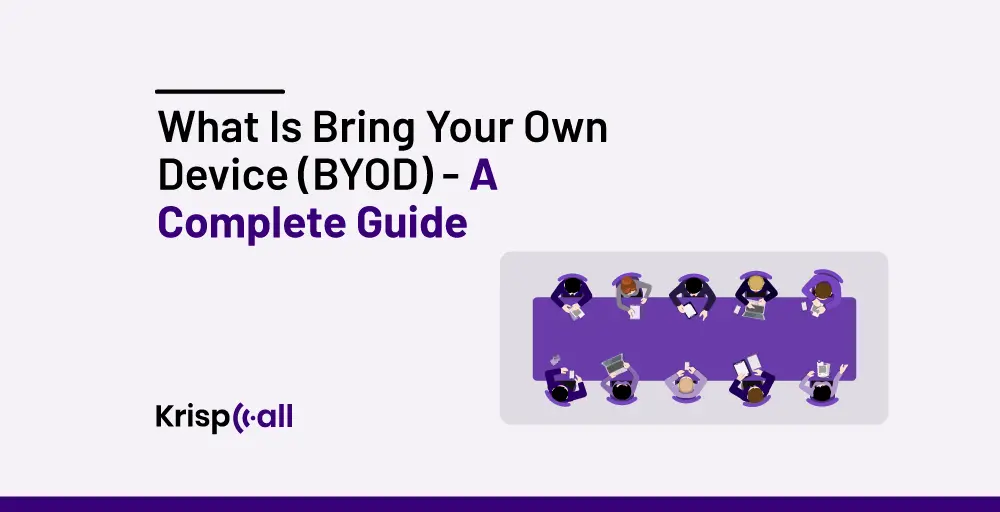Organizations always look 👀for various techniques to increase staff performance and job satisfaction. One popular approach businesses adopt is the Bring Your Own Device (BYOD) policy, where organization employees utilize their personal devices 📱 💻 for work.
BYOD can offer benefits such as cost savings and flexibility. Still, it has challenges, such as data security and compliance. This blog will discuss BYOD, its benefits and risks, how it works, and some guidelines on how to make it safe and beneficial for any company.
🔑KEY HIGHLIGHTS
- BYOD stands for Bring Your Own Device. It means using private devices, like smartphones, tablet computers, and laptops, in the work setting.
- BYOD has benefits like cost saving, increased productivity, flexibility, employee satisfaction, etc.
- BYOD security is the practice of protecting a business’s resources located on personally owned devices against threats that might cause risks.
- The major BYOD policies are access control, employee responsibilities, data management, usage monitoring, and security requirements.
- Data security, loss, and theft are BYOD risks. So are device management and privacy concerns.
What is Bring Your Own Device?
Bring Your Own Device is the company policy allowing employees to use their personal devices, such as laptops, tablets, and smartphones, for work purposes. This policy provides better ease and convenience to employees. Employees can connect to their organization’s networks and access work-related systems using devices they’re already familiar with, resulting in happy and satisfied employees.
Nonetheless, it’s essential to know that Bringing Your Own Device (BYOD) also has drawbacks. These include security and data issues, as company information can be vulnerable on personal devices. Many organizations have recognized this issue but still find the benefits of BYOD outweigh the risks.
To mitigate this issue, the organization must implement proper security measures and policies to protect their data and comply with legal standards.
How BYOD Works?
Under BYOD policies, employees can bring their devices to work and use them for emails, company apps, and files. But above all, organizations set up a BYOD policy to outline what devices are allowed and how they should be used. Then, employees register their devices in the IT department.
The IT department plays a crucial role here in securing the company’s information on personal devices. They install special software related to Mobile Device Management (MDM) and Enterprise Mobility Management (EMM) to control and protect the corporate data stored in these devices. Security measures can include complex passwords and data encryption. They can also include deleting stored information if the device is lost or seized.
Let’s check an example of how BYOD works:
Suppose a marketing firm implements a BYOD policy. Marketing manager Jane relies on her mobile to check work emails. She also uses it to talk to colleagues via apps and attend online meetings. The MDM solution implemented in the firm includes an app Jane must install on her phone. This app enforces security policies, requiring strong passwords and encrypting work data.
And if Jane misplaces her phone, the IT department can erase the corporate data on the lost phone. This prevents the company information from being compromised while Jane can comfortably work on her device.
What are the Benefits of Bring Your Own Device (BYOD)?
BYOD is crucial for any company. It cut the amount to purchase more devices required to perform tasks for companies. It also boosts employee satisfaction and work flexibility.
Some of the benefits of BYOD are:
- Cost savings: Businesses save money by not having to buy and manage company-owned devices. This extra cash can be used for other important things, helping the business grow and make more money.
- Increased productivity: Employees are often more comfortable and effective using their own devices. They’re familiar with their personal devices, which means they don’t waste time learning how to use new tools. This boosts productivity and makes work easier.
- Employee satisfaction: Encouraging BYOD will boost employees’ morale and satisfaction. Employees who choose their work tools are more encouraged and motivated.
- Flexibility: The BYOD policy enables employees to work from anywhere and anytime, which provides them with flexibility for huddle rooms.
- Access to advanced technology: Employees’ personal devices are often more up-to-date than company-provided ones because they tend to upgrade to the latest models more frequently. This means they can use the most advanced technology at work.
What is BYOD Security?
BYOD Security is the measures taken to ensure that the organizational information and assets accessed through personally owned devices, such as smartphones, tablets, laptops, etc., are secured against threats.
This includes strategies, measures, and solutions to guard against threats like data leakage, unauthorized access, and viruses. BYOD security aims to balance the benefits of using personal devices at work with the security challenges this approach introduces.
What is the Importance of BYOD Security?
The importance of BYOD (Bring Your Own Device) security lies in protecting company data and ensuring smooth operations. Here are some key reasons why it matters:
- Data Protection: Data protection is crucial in a BYOD environment. Personal devices are often more vulnerable to attacks and breaches, so it’s important to have security measures in place. These measures help ensure that only authorized users can access sensitive business information.
- Compliance: Many industries are subject to strict rules regarding data and information security and privacy standards, such as GDPR, HIPAA, or PCI-DSS. Breaking them could lead to fines. These rules also apply to using personal devices under BYOD policies. Compliance with these rules fosters trust with clients, business associates, and authorities. It shows a strong commitment to data protection.
- Network Security:
When personal devices connect to the company network, they can introduce risks like malware or unauthorized apps. Security protocols like VPNs, firewalls, and endpoint protection are crucial. They help prevent cyber threats and keep company networks secure.
- Device Management: Mobile Device Management (MDM) tools are essential for controlling and securing personal devices. IT teams can enforce security policies, remotely wipe lost devices, and manage access to company resources. Effective device management ensures data security across multiple devices.
- Employee Education: Educating employees about BYOD risks and best practices is vital. Training programs can teach them about secure device use, strong passwords, and avoiding risky apps. This awareness helps reduce security risks and protects the company from potential incidents.
What are the Best Practices of BYOD Security?
Some of the best practices of BYOD security are:
- Set clear policies and regulations: Employees must comprehend the policies and regulations concerning using personal devices at the workplace. This policy should describe what type of data can be accessed, security measures, and penalties for violating the policy.
- Encouraging strong passwords and authentication: Force staff to use complex passwords on their devices and other forms of authentication. This will make it harder for intruders to access the organization’s networks.
- Regular device updates: Ensure all devices are updated with the latest operating systems and applications. Updates fix security issues and help avoid the risk of getting a virus or malware on the system.
- Data encryption: Ensure that all sensitive data are encrypted at rest and during transmission. Encryption guarantees that even if data is captured or accessed by unauthorized persons, the information will still not be understandable.
- Use Mobile Device Management (MDM): Introduce the MDM policy. It controls and tracks employees’ mobile devices and maintains security policies. MDM can also wipe out devices’ data if lost or stolen.
What is the BYOD Policy?
BYOD Policy is a business policy that allows staff to do office work using their personal devices. An organization made this policy to manage the use of personally owned devices (like Smartphones, tablets, laptops, etc.) for work. This policy outlines how to access the firm’s information and resources on personal devices. It also covers the security and accountability needed for such information.
Some of the major BYOD policies are:
- Device Eligibility: Decide which devices (web phones, smartphones, tablets, laptops) are allowed under the BYOD policy and which operating systems are allowed. This protects company resources accessed through these devices.
- Security Requirements: Implement strict security policies. They may include restrictions, such as strong passwords, encryption, and anti-virus software. These requirements help keep company data safe. They stop random access and malware.
- Access Control: Define which data (company emails, applications, files, etc.) can be accessed using personal equipment. Access controls help restrict the information that only those with access rights can view or use.
- Data Management: There is a BYOD policy on handling organizational data on personal devices. It covers where and how to store, transfer, and delete information, which will help prevent information leaks.
- Support and maintenance: Determine how much support the IT department will provide for employees’ devices. This could involve helping with device setup, troubleshooting issues, and enhancing security measures. The aim is to ensure that employees’ devices are safe and effective for work use.
- Exit Procedures: Explain how to remove company data and its access from an employee’s devices. This is important when employees leave the company. Doing this ensures that all information about the company is well protected.
What are BYOD Risks & Challenges?
While BYOD can bring numerous advantages to organizations, it has some challenges and risks. Common challenges and risk factors of BYOD include the following:
- Data Security: When company data is stored on personal devices, it often lacks the necessary security measures. This makes it easier for breaches to happen, especially if employees aren’t following security protocols.
- Compliance Issues: Complying with industry standards and company policies regarding personal devices can be tricky. Companies that fail to comply could face serious legal repercussions and fines, especially in sensitive fields.
- Loss and Theft: Personal devices are easier to lose or steal than company devices. If this happens, sensitive company information could be exposed, and recovering that data can be tough.
- Device Management: Multitasking may become a challenge for IT departments when working with multiple devices equipped with different OSs and various levels of security. This diversity makes it challenging to implement compliance with security policies across all the devices.
- Privacy Concerns: Employees might be worried about their privacy when using personal devices for work. They may feel like the company monitors their activities, which can lead to trust issues.
How to Overcome BYOD Risks & Challenges?
To overcome the risks and challenges of BYOD, follow these points:
- Implement Robust Security Measures: Encourage employees to use strong passwords, encrypt devices, and use antivirus. These measures ensure that company data is secured from access or cyber assaults.
- Use Mobile Device Management (MDM): MDM solutions can help track and manage employees’ devices. They allow companies to enforce security policies, locate lost devices, and wipe data if devices are stolen, reducing the risk of data leaks.
- Conduct Regular Training and Awareness Programs: The organization should train the employees on the necessity of protecting BYOD devices and the right measures to take when protecting them. It is recommended that monthly training sessions be conducted to inform employees of their responsibilities toward the company’s information and the security measures they should adhere to.
- Set Clear BYOD Policies and Compliance Checks: Establish clear BYOD policies outlining mandatory security measures and compliance requirements. Regular audits and checks ensure these policies are followed on personal devices.
- Separation of Personal and Work Data: Encourage employees to separate personal and business data within their devices. This approach keeps the company data safe and protects it from other parts of the end user’s private life.
Conclusion
BYOD benefits both businesses and employees. For businesses, it saves money on buying new hardware equipment like PCs, cables, etc. Likewise, it allows employees to use their devices at work, increasing efficiency and satisfaction with familiar devices.
However, these policies create security and data management issues. Organizations must implement strict measures to mitigate these issues, including MDM solutions, data encryption, and frequent training for employees to handle mobile devices securely.




